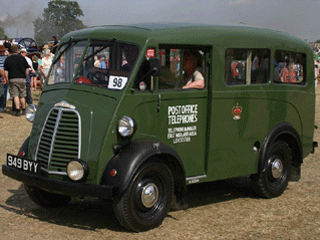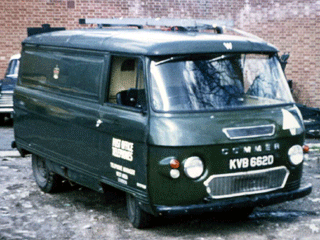Mid-Bronze Green Livery
 |
|
The vehicles of Post Office Telephones, within these pages, span many years, from the 1930s to the early 1970s. This period included the change from mid-bronze green to golden yellow paint livery, in 1968, leading up to the new name of Post Office Telecommunications in 1969. Examples of older branding continued into the 1970s, until newer vehicles were phased in.
Manufacturers included: Albion, Morris, Ford and Land Rover. This section illustrates a selection of vehicles, many of which have been preserved in public collections, or private ownership.
| Albion | |
 |
Albion trucks were first purchased by the Post Office in the early 1930s. In common with other vehicles, which later became part of the Post Office Fleet, the Albion telephone utility was specified with a custom - built bodywork. |
| Morris Minor Variants | |
 |
Early Morris Minor 5 cwt. vans were specified with custom built bodies to Post Office design. As the Morris Eight became available the Minor chassis was combined with the Eight's engine to form a Post Office Telephones' hybrid. |
| Morris CV11/40 | |
 |
This 1946 Morris Commercial CV11/40 30 cwt, Utility (U39896 reg GYY107) is held by the British Postal Museum and Archive, at Debden. |
| Morris LC Series | |
 |
This 1949 Morris Commercial LC3 Utility (U48545 reg JUW 830) was winner of the POVC (Post Office Vehicle Club) Amberley trophy in 2007. |
| Morris Z Van | |
 |
The Morris 'Z' chassis 5 cwt van was produced between 1940 - 1953 and was used on telephone duties for Post Office Telephones. |
| Morris Mini | |
 |
This 1962 Morris Mini van (167 ELP) 5cwt telephone utility worked in East London Area until 1969. 167 ELP was winner of the POVC (Post Office Vehicle Club) Amberley trophy in 2009. |
| Morris J | |
 |
From about 1957 onwards, the GPO purchased more than 6000 Morris J type vans for both postal and engineering duties. |
| Morris J2 | |
 |
In the Sixties, the Morris J2 was typically assigned to a geographical work area and was commonly seen with the white lettering POST OFFICE TELEPHONES, TELEPHONE MANAGER (AREA). |
| Morris Minor | |
 |
Preserved Minor Utility BYE232B at the Kemble Steam and Vintage Show 2nd August 2009. It is thought that the ladder rack was removed at the local workshop, before the vehicle entered service. |
| Ford | |
 |
During the 1960s, the Ford Anglia 5cwt was the preferred choice of small utility vehicle, for Post Office Telephones work. |
| Commer | |
 |
During the late 1960s the Commer van displaced the Morris J2 as the most ubiquitous telecom vehicle on the streets. |
| Land Rover | |
 |
A 1967 Land Rover in splendid Post Office Telephones mid-bronze green. SYF 11F was originally based in the Crayford and Canterbury engineering centres and was used when a 4-wheel drive vehicle was required. |
 |
P.O. Engineering Department |
| BSA Motorcycle | |
 |
AGT 23 is a 1933 BSA telephone engineer's motorcycle and sidecar which is part of the Connected Earth collection at Amberley Museum. |
| G.P.O. Handcart | |
 |
GPO Handcart No.1475 seen at Amberley April 2010 |
| Golden Yellow Livery | |
 |
In 1968, Golden Yellow was adopted as the new 'safety' colour for all telecommunication vehicles and the white lettering was changed to grey-green. And from 1973, the words 'Telephone Manager' were phased out. Some vehicles were repainted in golden yellow, thus it is possible to find registration marks prior to letter G (August 1968) in the new livery. |
All logos and trade marks are the property of their respective owners and are used on the Light Straw site(s) for review only. Students and researchers are recommended to make their own independent enquiries as to the accuracy of the information contained therein.